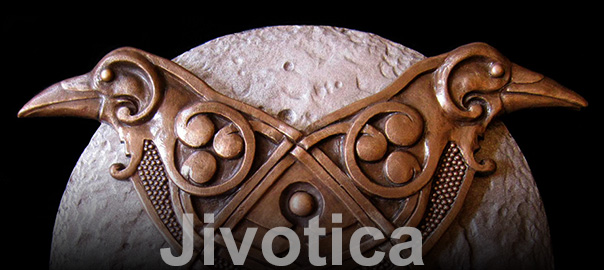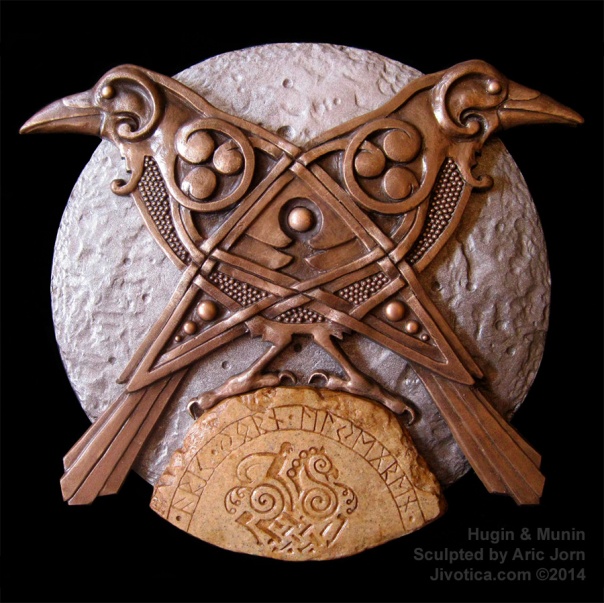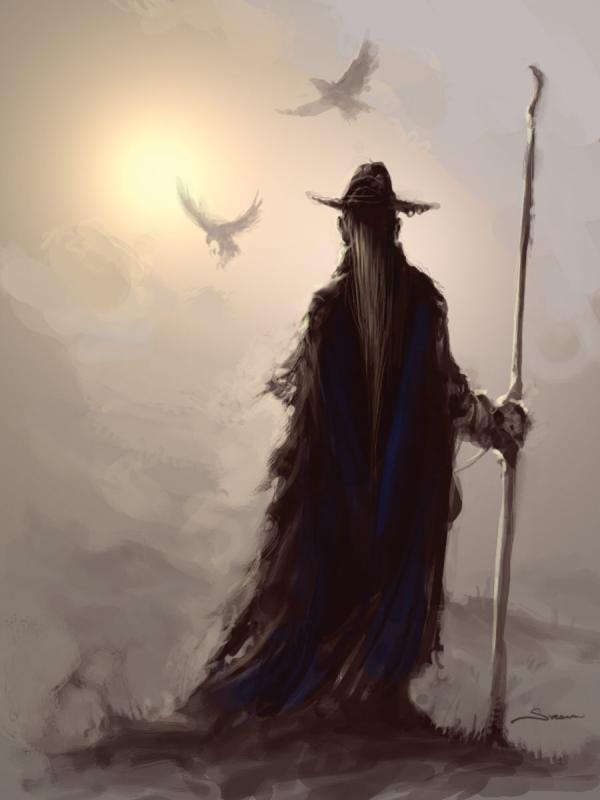The next piece in my “Sculpting Myth” series (available in my Jivotica gallery store and limited to 150 signed/numbered castings) explores another symbol from my Norse heritage, the pair of ravens who served none other than Odin, the All Father, himself. Their names are Hugin and Munin and they were sent out each day to fly around Midgard (Earth) and report back on the events of the world (it is in this way that Odin achieved something like Omniscience.)
The ravens are shown intertwined in knotwork to symbolize their interconnectedness – not only to each other, but also to Odin, the physical world and the knowledge they seek. They are perched on a rune stone upon which is carved a sampling of Futhark (the Norse alphabet) and a depiction of Odin astride his eight-legged horse, Sleipnir.
This piece is fashioned from four separate reliefs using cold-cast bronze, nickel silver and stone-infused resin. Next, patinas, inks and paints are applied and the pieces are buffed to bring out highlights. They are then assembled, covered with a clear coat and mounted in a beautiful black shadowbox frame.
Because they are closely associated with the seeking of knowledge and the king archetype, people often display images of Hugin and munin in their library, study, office or wherever they do their most profound thinking or make their biggest decisions.
Digging deeper into the story of Hugin and Munin…
The Eddic poem Grímnismál mentions Odin’s thoughts on Hugin and Munin:
Hugin and Munin
Fly every day
Over all the world;
I worry for Hugin
That he might not return,
But I worry for Munin more.
The names Hugin and Munin are commonly translated as “thought” and “memory” respectively. While it is widely accepted that the name Hugin does indeed mean “thought” (derived from the Old Norse “hugr”), given that the Old Norse word for memory is “minni,” it is more likely that Munin is derived from the Old Norse word “munr” meaning “desire.”
So, with this alternate translation in mind, Odin seems then to be saying that he is worried about losing his mental faculties (thought), but is more worried about losing his zest for life (desire). I think this expresses the importance placed on a raw passion for life that is fundamental to the Viking world view.
For additional information on Hugin and Munin (and other tales of Norse mythology), I strongly recommend the site Norse-Mythology.org
This piece has joined the others on my Etsy store and I will also have them available at the Ann Arbor Artisan Market. As always, I welcome your comments and suggestions.
~Aric Jorn




Where are those runes from? The first two words are F R I G and J/Y O R G, but I’m not sure about the third… it is either trying to say L I L J/Y E G R E N or A I L J/Y E G R E N…
I’m just curious… it doesn’t seem to add to the piece… or maybe it does.
It is an epic design, I really dig the meaning behind it.
LikeLike
Thanks for your question – you are not the first person to ask me this 🙂
In fact, the first word is “ARIC” (ARIK actually, since old futhark didn’t have a letter “c”) and the second is “JORN” (N easily confused with G since the runes are very similar, but if you look closely, you can spot the difference.) You’ve nailed the third – “LILJEGREN.”
I added the runes to capture the look and feel of a rune stone. I didn’t want there to be so much writing that it stole focus from the rest of the piece, so I simply spelled out my full name (ARIC JORN LILJEGREN). This serves the dual purpose of identifying myself as the artist.
Thanks for the comment – I’m glad you like the piece!
~Aric
LikeLike
Ah-ha!
haha…
It’s funny how the mind sees what it wants at times, I can’t believe I misread that.
It’s a little embarrassing – I know the elder futhark script like the back of my hand!
The inscription does indeed add to the piece.
Thank you for replying and clearing that up for me.
And again; it is a stunning work of art.
LikeLike
My grandmothers maiden name was liljegren, from Sweden.
LikeLike
John,
Thanks for sharing. In my case, it was my great-grandfather who brought the name Liljegren to the states in the early 1900s. They were also from Sweden.
~Aric
LikeLike
The artist controls his work..Which by the way is excellent in my humble opinion 🖤🐺
LikeLike
Please note that this is an old version of the site and is no longer monitored. Please go to http://www.jorn.com to see the latest from Aric Jorn Studios (previously Jivotica). Many thanks ~Aric
LikeLike
You are most welcome. Be sure to check back at year’s end when I will be announcing my next piece. I can’t say what it is yet but, as you like the Hugin and Munin, you should be pleased.
~Aric
LikeLike
Would love to be able to order from Canada. Is this possible? As going through etsy site it seems unlikely
LikeLike
Yes, I ship all over the world. Etsy does not yet have a reliable shipping calculator for international orders, so I have to quote shipping for each customer. You can email me through this site or convo me through Etsy with your selections and I will send you a quote that includes international shipping options.
~Aric
LikeLike
I checked into shipping on Hugin and Munin for you and it looks like it will run $45 for Priority Mail with full insurance, tracking and my signature packaging which has recently been described as “bullet proof.”
LikeLike
Just wondering if there is a historical reference piece for these Ravens or if this is your own design?
LikeLike
Thanks for the question, Dan. Some of my pieces are based on historic artifacts – my Mjolnir, for instance, is taken from the famous “raven head hammer” found in Skane, Sweden, and my Prow is based directly on the Oseberg ship. However, an ever-increasing proportion of my work is original and this includes “Odin’s Ravens: Hugin and Munin.” I have incorporated patterns and motifs that echo the culture, but the design is my own.
As an artist seeking to discover my own Scandinavian heritage, I don’t want to rely solely on replicating the work of my ancestors (there are enough artists out there doing that already), rather I try to channel and interpret the stories through my own aesthetic. I do this both to honor the traditions of my forebears and to celebrate my own voice as an artist in the process.
~Aric
LikeLike